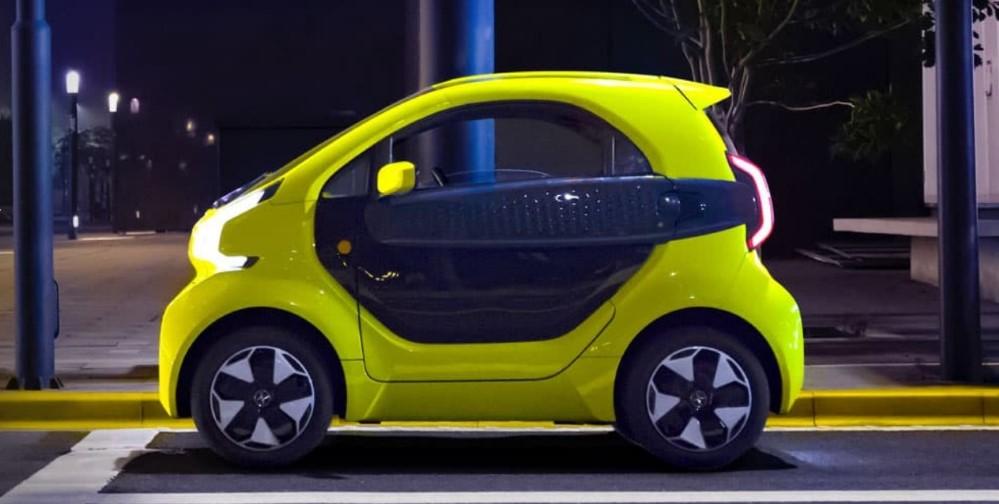Editor-in-Chief
- FMA
- The Fabricator
- FABTECH
- Canadian Metalworking
Our Publications
Categories
- Additive Manufacturing
- Aluminum Welding
- Arc Welding
- Assembly and Joining
- Automation and Robotics
- Bending and Forming
- Consumables
- Cutting and Weld Prep
- Electric Vehicles
- En Español
- Finishing
- Hydroforming
- Laser Cutting
- Laser Welding
- Machining
- Manufacturing Software
- Materials Handling
- Metals/Materials
- Oxyfuel Cutting
- Plasma Cutting
- Power Tools
- Punching and Other Holemaking
- Roll Forming
- Safety
- Sawing
- Shearing
- Shop Management
- Testing and Measuring
- Tube and Pipe Fabrication
- Tube and Pipe Production
- Waterjet Cutting
Industry Directory
Webcasts
Podcasts
FAB 40
Advertise
Subscribe
Account Login
Search
YO, electric vehicles are speeding adoption of 3D printing
Strong and light 3D-printed parts appeal to EV-makers
- By Don Nelson
- January 23, 2022
The production model of a new electric vehicle called YOYO hit the streets of Europe late last year. The well-appointed, ultracompact EV is designed for city use and is affordably priced.
Built by XEV, which has offices in China and Italy, the battery-powered car measures 100 in. long by 59 in. wide; weighs less than 1,000 lbs.; and has a range of 95 miles, a top speed of 50 mph, and starts at $14,700.
A cool feature of the YOYO is its three lightweight, easy-to-replace batteries. They can be recharged by plugging them into a regular electrical outlet instead of a special charger. Also noteworthy is that many of the EV’s components are 3D-printed, making it easier to order custom features for a new car.
Traditional methods of car-building involve expensive, complicated molds and tools that are part-specific. “Our 3D printing production line,” says XEV, “virtually eliminates the need for such limited and resource-intensive tooling, resulting in a flexible and efficient manufacturing process.”
Moreover, because additive manufacturing allows design modifications to be made with relatively little re-engineering, buyers can inexpensively customize a YOYO’s interior and exterior.
The EV market offers many opportunities to expand AM’s use among automakers. This is largely due to the, well, surge in sales of plug-in vehicles the past few years.
According to a report posted to the InsideEVs website, global sales of plug-in vehicles topped 721,000 in November 2021—an all-time monthly sales record and a 72% year-over-year increase. (Figures do not include sales of non-rechargeable hybrid vehicles like the Toyota Prius.) The previous record, 685,881, was set in September 2021. Through November, 2021 sales exceeded 5.57 million units. Sales for all of 2020 were 3.1 million.
Additive improves the manufacturing of EVs in other ways than just allowing buyers to economically customize a new car. For example, because 3D-printed parts weigh less than machined parts, they lighten the cars they’re installed in, which, in turn, extends battery life.
Another way AM sheds weight is by allowing multiple parts to be designed and printed as a single structure. A monolithic structure is both lighter and stronger than one welded or fastened together from multiple parts.
3D Systems’ transportation and motorsports segment leader, Kevin Baughey, lists a few other benefits of 3D printing in an article he wrote that was posted to the Today’s eMobility website. AM lets automakers:

Global sales of plug-in electric cars reached more than 721,000 in November 2021–an all-time monthly record. The graph, produced by InsideEVs, is based on data collected by EV Volumes.
• 3D-print strong, robust parts that can withstand the rigors of the road, thanks to the development of new polymers and metals.
• Fabricate casings with more intricate shapes and thinner walls, allowing manufacturers to stack battery plates more efficiently within the propulsion system.
• Optimize thermal performance to extend the range of the vehicle in the short term and lengthen battery life in the long term.
(Click here to read The Additive Report’s interview with Baughey about AM’s role in Formula One racing.)
Besides parts, a number of manufacturers have committed significant R&D money to studying ways to 3D-print EV batteries at scale. Their efforts—if successful—will further lighten cars and give a charge to additive manufacturing’s use.
About the Author

Don Nelson
2135 Point Blvd.
Elgin, IL 60123
(815)-227-8248
About the Publication
- Podcasting
- Podcast:
- The Fabricator Podcast
- Published:
- 04/16/2024
- Running Time:
- 63:29
In this episode of The Fabricator Podcast, Caleb Chamberlain, co-founder and CEO of OSH Cut, discusses his company’s...
- Trending Articles
- Industry Events
16th Annual Safety Conference
- April 30 - May 1, 2024
- Elgin,
Pipe and Tube Conference
- May 21 - 22, 2024
- Omaha, NE
World-Class Roll Forming Workshop
- June 5 - 6, 2024
- Louisville, KY
Advanced Laser Application Workshop
- June 25 - 27, 2024
- Novi, MI



























